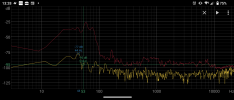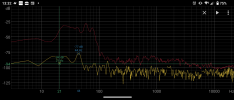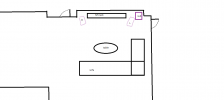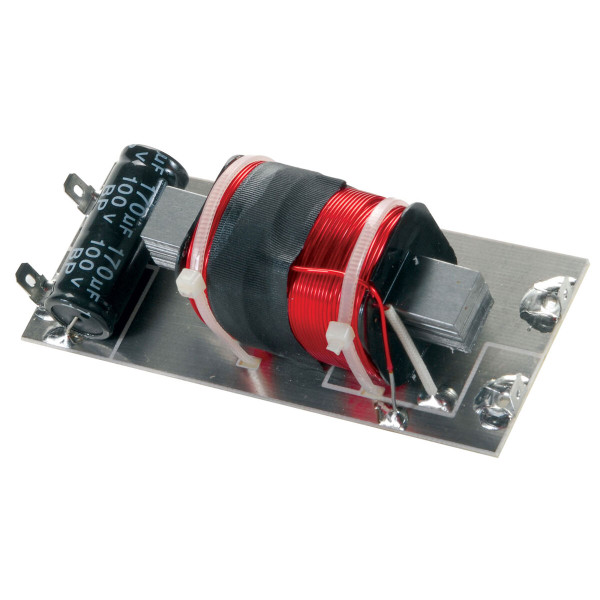Hey everyone.
So I just got a subwoofer and for the first time I had to take some measurements in order to calibrate it with my Stereo system.
My system is as follows:
Triangle Quartet Genese speakers - advertised at 35hz-20khz +-3db
Dynavoice T12 subwoofer - advertised at 500w and 23-200hz +-3db, crossover settings 35-150hz
Yamaha A-S2100 integrated amp
Cambrdige Audio CXNv2 streamer + CXC cd transport.
I've attached 3 pictures. The first 2 are from the Spectroid app of the measurments, first one without SUB, second with SUB after calibration. The 3rd one is a rough MS PAINT sketch of my listening room (all walls are solid).
I calibrated it, as specified, using the Spectroid app on my Sony Xperia IV which has (allegedly) high quality (for a smartphone) stereo mics. I ran an mp3 320 kbs file with 20-80 hz sweep. The line that is relevant here is the RED one.
In the first image, which is without sub, I was surprised to see that the energy that the speakers produce down to roughly 24hz is in line with the rest of the sub-bass range. This is quite a nice surprise considering the speakers official specs (35hz minimum). I understand rooms play a huge part.
The 2nd image is where it gets interesting. After multiple settings tests with the sub, I managed to get the most out of it with phase at 180 degrees (with 0 degrees I got less bass than without a sub), volume at around 40%, crossover at the lowest limit the sub offers, which is a 35hz cutoff. This way I got the most energy below the 24hz I got from the speakers alone, in this case, as you can see, the frequency cutoff went down to about 22hz with a bit more energy in the subbass area than without a sub, which is to be expected as the official specs of the sub say they produce down to around 23hz +-3db.
Now here's my dilemma. As much as I tried (and I tried different settings, multiple positions) I could not get a better integration and a lower extension than around 22hz, and that is quite good as this is all in-line with what the sub is advertised to be capable of. HOWEVER, given that my speakers (in my room) perform so good in the lower frequencies, and they can go with more than decent audible energy to roughly 24hz - does my system really needs a sub?
The audible differences are as you could deduce from the graphs. A bit more (but just a BIT) rumble, but nothing crazy, and judging by how low my speakers go, I'm not sure how much more the sound quality could benefit from a much much more expensive and bigger sub that could maybe add 1-3 extra hz down.
So I just got a subwoofer and for the first time I had to take some measurements in order to calibrate it with my Stereo system.
My system is as follows:
Triangle Quartet Genese speakers - advertised at 35hz-20khz +-3db
Dynavoice T12 subwoofer - advertised at 500w and 23-200hz +-3db, crossover settings 35-150hz
Yamaha A-S2100 integrated amp
Cambrdige Audio CXNv2 streamer + CXC cd transport.
I've attached 3 pictures. The first 2 are from the Spectroid app of the measurments, first one without SUB, second with SUB after calibration. The 3rd one is a rough MS PAINT sketch of my listening room (all walls are solid).
I calibrated it, as specified, using the Spectroid app on my Sony Xperia IV which has (allegedly) high quality (for a smartphone) stereo mics. I ran an mp3 320 kbs file with 20-80 hz sweep. The line that is relevant here is the RED one.
In the first image, which is without sub, I was surprised to see that the energy that the speakers produce down to roughly 24hz is in line with the rest of the sub-bass range. This is quite a nice surprise considering the speakers official specs (35hz minimum). I understand rooms play a huge part.
The 2nd image is where it gets interesting. After multiple settings tests with the sub, I managed to get the most out of it with phase at 180 degrees (with 0 degrees I got less bass than without a sub), volume at around 40%, crossover at the lowest limit the sub offers, which is a 35hz cutoff. This way I got the most energy below the 24hz I got from the speakers alone, in this case, as you can see, the frequency cutoff went down to about 22hz with a bit more energy in the subbass area than without a sub, which is to be expected as the official specs of the sub say they produce down to around 23hz +-3db.
Now here's my dilemma. As much as I tried (and I tried different settings, multiple positions) I could not get a better integration and a lower extension than around 22hz, and that is quite good as this is all in-line with what the sub is advertised to be capable of. HOWEVER, given that my speakers (in my room) perform so good in the lower frequencies, and they can go with more than decent audible energy to roughly 24hz - does my system really needs a sub?
The audible differences are as you could deduce from the graphs. A bit more (but just a BIT) rumble, but nothing crazy, and judging by how low my speakers go, I'm not sure how much more the sound quality could benefit from a much much more expensive and bigger sub that could maybe add 1-3 extra hz down.






